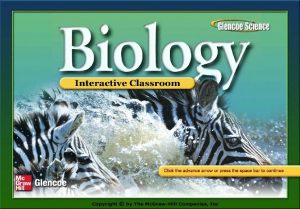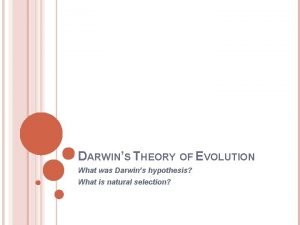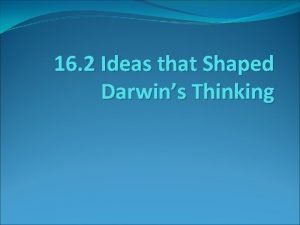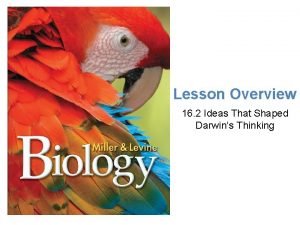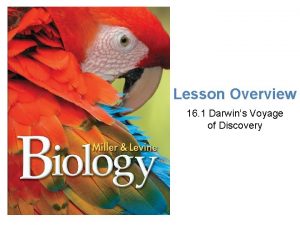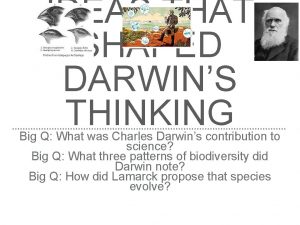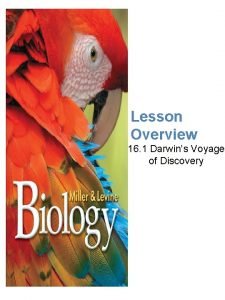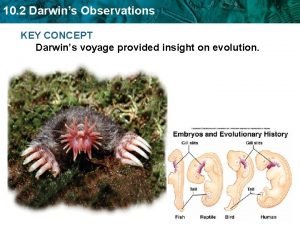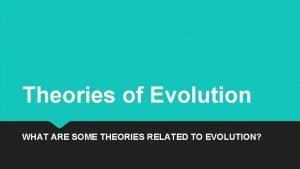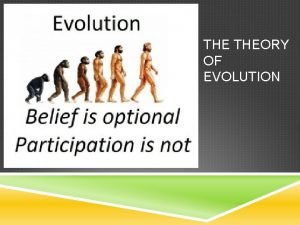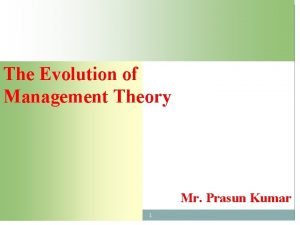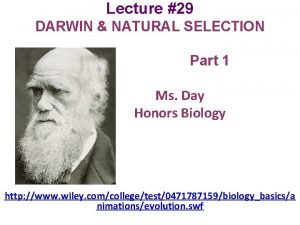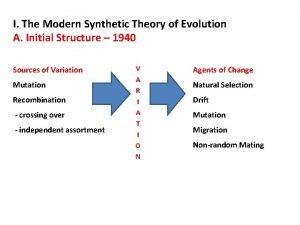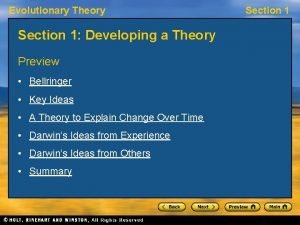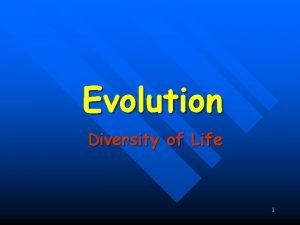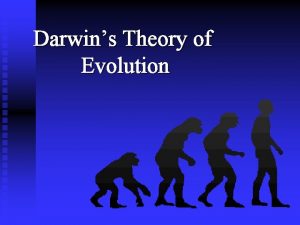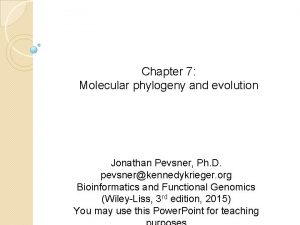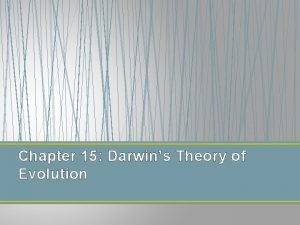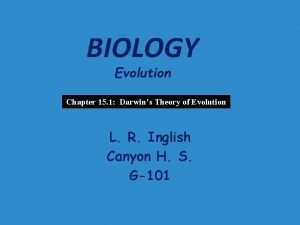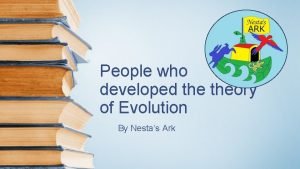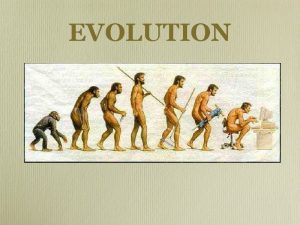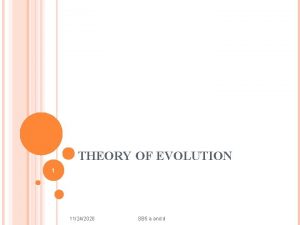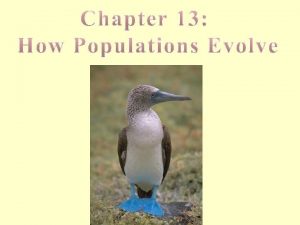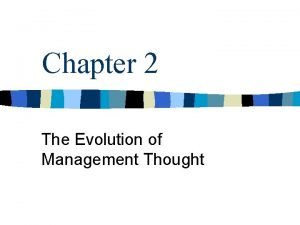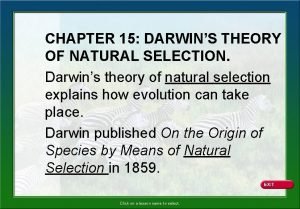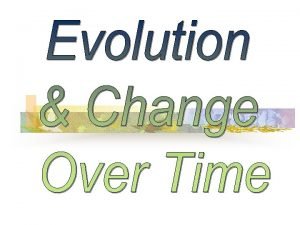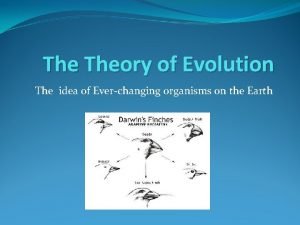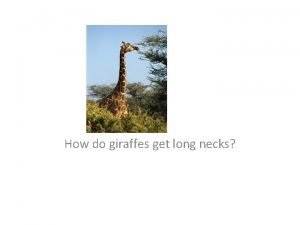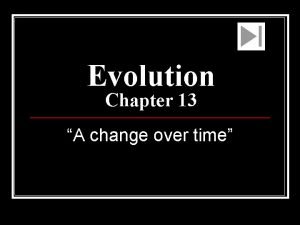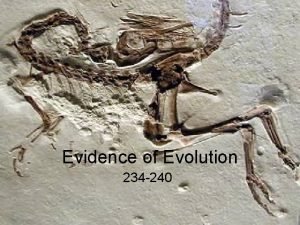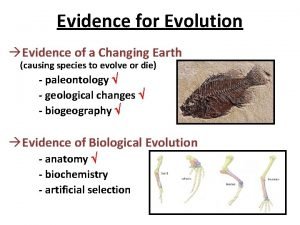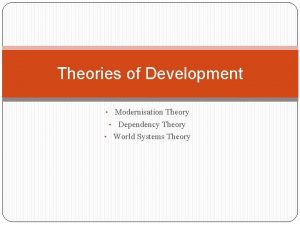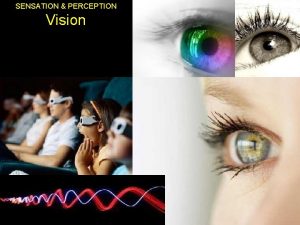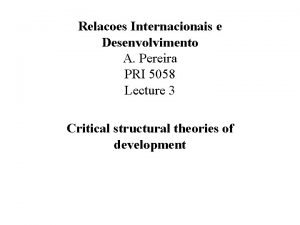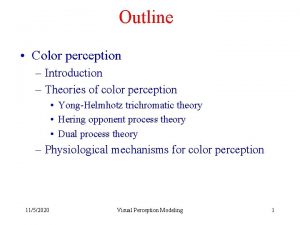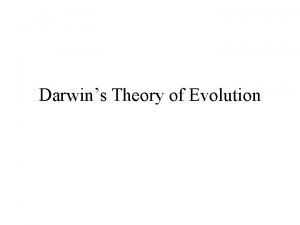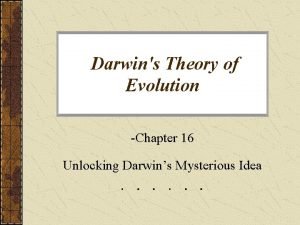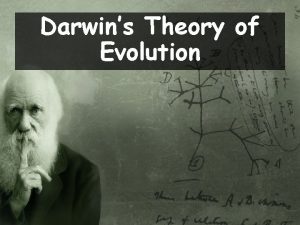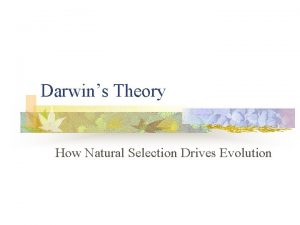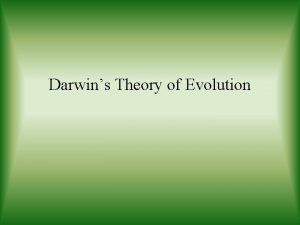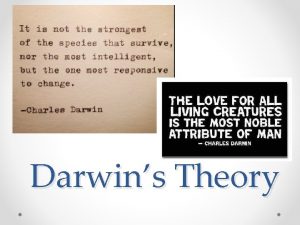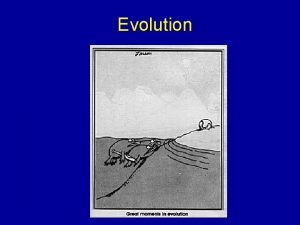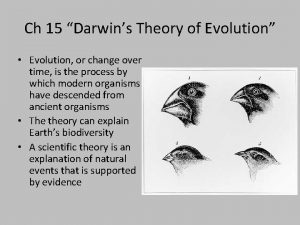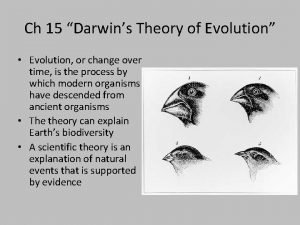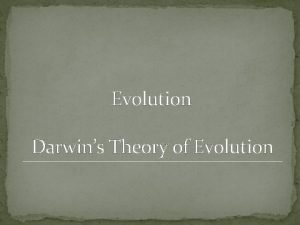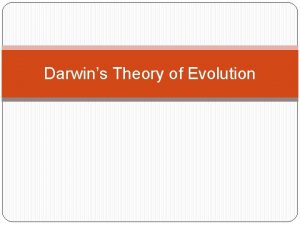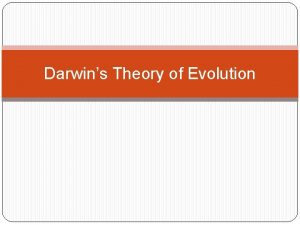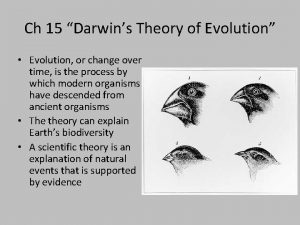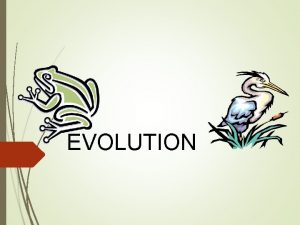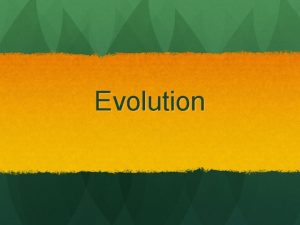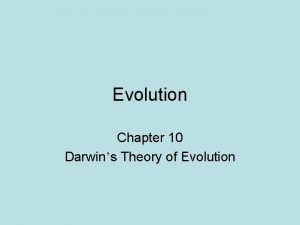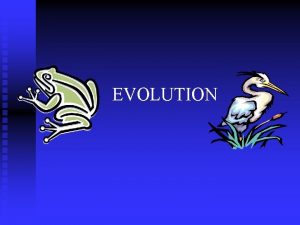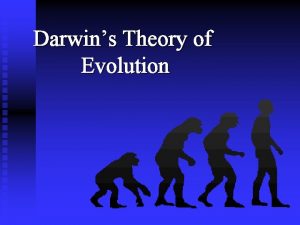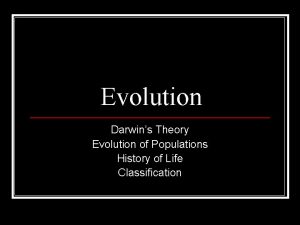Darwins Theory of Evolution Darwins Theory of Evolution
















































- Slides: 48

Darwin’s Theory of Evolution

Darwin’s Theory of Evolution When Darwin set out to explore the Galapagos Islands, the average person believed the world was 6, 000 years old. Everyone, including Darwin, believed that plants and animals were unchanging, meaning they did not change and would not change.

Darwin’s Theory of Evolution Darwin’s Goals: (Five year expedition) 1) To discover, survey, and map the coast of South America. 2) Collect various rocks, fossils, plants, and animals.

Darwin’s Theory of Evolution During his journey, Darwin also began reading Charles Lyell’s Principles of Geology, which made arguments that the earth was millions of years old. Remember, at the time of his expedition, it was believed that the world was only 6000 years old… How would these arguments influence Darwin’s work?

Darwin’s Theory of Evolution Well, it provided answers for… n Marine fossils found in the Andes Mountains. n Giant fossil versions of smaller living animals. n Changes in rock elevation due to earthquakes.

The Galapagos Islands

Darwin’s Theory of Evolution At first, Darwin was disappointed with the bareness of the islands. However, he quickly discovered something unique about his collection of plants and animals. They were different, but the same…

Darwin’s Theory of Evolution Darwin then realized that each island had its own variety of the same animals! There were finches, mockingbirds, and other animals on all the islands. However, each grouping of finches, mockingbirds, etc. were unique in some way.

Darwin’s Finches and the Galapagos Darwin noted the different species of giant tortoises on the different islands of the Galapagos.

Darwin’s Finches and the Galapagos He was impressed with Patagonian fossils and the diversity of life in the Galapagos Islands. Darwin was also struck by the fact that there were 14 different species of finches, each with a beak shape and size that was adapted to its particular ecological niche.

Darwin’s Theory of Evolution Years later, Darwin discovered that each specimen was actually a separate species, meaning they could not interbreed. So, even though these species resembled related species from other parts of South America, they were still uniquely different. But how could this be? ? ?

Darwin’s Theory of Evolution Darwin figured that new species could appear gradually through small changes over time, but he still couldn’t figure out how it worked. *Artificial Selection: a process of selective breeding where the breeder will select animals with certain traits to breed with others in hopes of producing offspring with the same traits.

Darwin’s Theory of Evolution Adaptation: all organisms are suited to their environments. Variation: all organisms differ in their traits. Over-reproduction: all organisms tend to reproduce beyond their environment's capacity to support them.

Darwin’s Theory of Evolution Deduction 1: Organisms have an enormous capacity to overproduce. Deduction 2: Populations (with a few exceptions) remain remarkably stable. Deduction 3: There must be a struggle for survival.

Darwin’s Theory of Evolution Deduction 4: Individuals differ in their characteristics and many of these differences are heritable (genetic). Deduction 5: Those individuals who possess adaptive characteristics will reproduce more successfully than those who don’t AND will pass on these characteristics to their offspring.

Darwin’s Theory of Evolution Since not all organisms are equally well adapted to their environment, some will survive and reproduce “better” than others -- this is known as natural selection. Sometimes this is referred to as "survival of the fittest. ” In reality, this deals with the reproductive success of the organisms and not solely their relative strength or speed.

Natural Selection determines the differential survival of groups of organisms

Evidence of Evolution

Darwin’s Theory of Evolution: the result of genetic changes that occur in constantly changing environments.

The fossil record

Darwin’s Theory of Evolution Fossils offer some of the most significant evidence of evolutionary change. They provide a record of various species that have lived and died. They also provide evidence of change.

Darwin’s Theory of Evolution Ancestral Traits: primitive features that DO appear in ancestral forms over time. Derived Traits: newly evolved features that do NOT appear in the fossils of common ancestors.

Homologous Structures: similar structures acquired from a common ancestor.

Darwin’s Theory of Evolution Analogous Structures: parts of different organisms that have similar forms and functions, but different internal structures (wing of a bird & wing of an insect).

Darwin’s Theory of Evolution Vestigial Structures: remnants of structures that were once functional in an ancestral form (appendix, wisdom teeth, coccyx, nictitating membrane).

Kiwi birds have wings but don’t use them.

The human appendix.

Snakes have a pelvic bone with two hind limb claws still attached. Snakes have legs?

Bat Wing vs. Bird Wing

Darwin’s Theory of Evolution Vertebrate embryos provide more glimpses into evolutionary relationships. Scientists have found that vertebrate embryos go through similar cycles during development. In time they differ, but during the early stages they look alike.



Darwin’s Theory of Evolution Adaptation: A trait shaped by natural selection that increases an organism’s reproductive success. An organism’s adaptation is only as strong as the next generation. The better an organism is adapted to its environment, the greater its chances of survival and reproductive success.

Darwin’s Theory of Evolution Camouflage: species evolve morphological adaptations that allow them to blend with their natural environments. Camouflage basically lets organisms become invisible to predators. Those that hide, survive. Those that survive, reproduce.

Darwin’s Theory of Evolution http: //science. howstuffworks. com/animal-camouflage 2. htm

Frogs have done it.

Birds are doing it.

Even fish have figured it out.

Darwin’s Theory of Evolution Mimicry: One species evolves to resemble another species. *Harmless species tend to take on the traits and looks of more harmful species, therefore avoiding predators.

Top: the harmless mimic, Allobates zaparo. Middle: Epipedobates bilinguis, the toxic poison dart frog that A. zaparo mimics when all three frogs occur together. Bottom: E. parvalus, the more abundant, more toxic poison dart frog.

Darwin’s Theory of Evolution Plants adapt. Animals adapt. People adapt. Disease adapts!

Darwin’s Theory of Evolution Species of bacteria that originally were killed by penicillin and other antibiotics have developed drug resistance. For every cure there is at least one strand that cannot be cured. The more we cure, the more incurable strands develop.


Other factors within evolution.

Darwin’s Theory of Evolution Disruptive Selection: a population evolves into two groups after being split for some reason. (In these cases, the extremes survive and those in the middle are wiped out). Example: Black bunnies, grey bunnies, and white bunnies live in an area where there is an abundance of black stones and white stones. The black and white bunnies will survive, but the grey won’t. Why?

Others adapt certain characteristics that are more appealing to the opposite sex. This is called sexual selection.

Darwin’s Theory of Evolution There are times when unrelated species evolve similar traits and look alike even though they are very different. Convergent Evolution: occurs in environments that are geographically far apart but have similar ecologies and climates.

 Chapter 17 darwin's theory of evolution
Chapter 17 darwin's theory of evolution Chapter 15 section 1 darwins theory of natural selection
Chapter 15 section 1 darwins theory of natural selection Darwin hypothesis
Darwin hypothesis Section 15–2 ideas that shaped darwin’s thinking
Section 15–2 ideas that shaped darwin’s thinking 15-2 ideas that shaped darwin's thinking
15-2 ideas that shaped darwin's thinking Adaptation
Adaptation Lesson 2: ideas that shaped darwins thinking
Lesson 2: ideas that shaped darwins thinking Species that vary locally
Species that vary locally Ideas that shaped darwins thinking
Ideas that shaped darwins thinking Lesson 1 darwins voyage of discovery
Lesson 1 darwins voyage of discovery Darwins observations
Darwins observations Lamarck's theory of evolution
Lamarck's theory of evolution Developmental homologies
Developmental homologies Evolution of management theory
Evolution of management theory Lamarck's theory
Lamarck's theory Modern synthetic theory of evolution notes
Modern synthetic theory of evolution notes Modern evolution theory
Modern evolution theory Lamarck’s theory of evolution.
Lamarck’s theory of evolution. Vestigial
Vestigial Chapter 15 darwin's theory of evolution section 15-1
Chapter 15 darwin's theory of evolution section 15-1 Neutral theory of molecular evolution notes
Neutral theory of molecular evolution notes Shaping evolutionary theory
Shaping evolutionary theory Chapter 15 darwin's theory of evolution section 15-1
Chapter 15 darwin's theory of evolution section 15-1 Chapter 15 darwin's theory of evolution section 15-1
Chapter 15 darwin's theory of evolution section 15-1 Explain the theory of evolution
Explain the theory of evolution Theory of natural selection
Theory of natural selection Lamarck theory of evolution notes
Lamarck theory of evolution notes Theory of evolution
Theory of evolution Theory of evolution
Theory of evolution Introduction to evolution of management
Introduction to evolution of management Chapter 15 darwin's theory of evolution
Chapter 15 darwin's theory of evolution Homologous structures examples
Homologous structures examples Law of natural selection
Law of natural selection The image below shows phiomia an ancestor of elephants
The image below shows phiomia an ancestor of elephants Darwin's theory of evolution
Darwin's theory of evolution Analogous structures definition
Analogous structures definition The theory that evolution occurs slowly but steadily
The theory that evolution occurs slowly but steadily Lamarckian evolution
Lamarckian evolution The theory that evolution occurs slowly but steadily
The theory that evolution occurs slowly but steadily Trait theory of leadership
Trait theory of leadership Compare continental drift and plate tectonics
Compare continental drift and plate tectonics Modernization theory vs dependency theory
Modernization theory vs dependency theory Colour design: theories and applications
Colour design: theories and applications Modernization theory vs dependency theory
Modernization theory vs dependency theory Continental drift vs plate tectonics theory
Continental drift vs plate tectonics theory Opponent process theory vs trichromatic theory
Opponent process theory vs trichromatic theory Neoclassical organization theory
Neoclassical organization theory Motivation in group formation
Motivation in group formation Hawthorne theory of motivation
Hawthorne theory of motivation

